Study Skills for Higher Education
VerifiedAdded on 2022/12/26
|8
|2201
|1
AI Summary
This report analyzes the concept of VARK and discusses various learning styles associated with it. It provides recommendations for teachers to create lessons based on the VARK learning style.
Contribute Materials
Your contribution can guide someone’s learning journey. Share your
documents today.
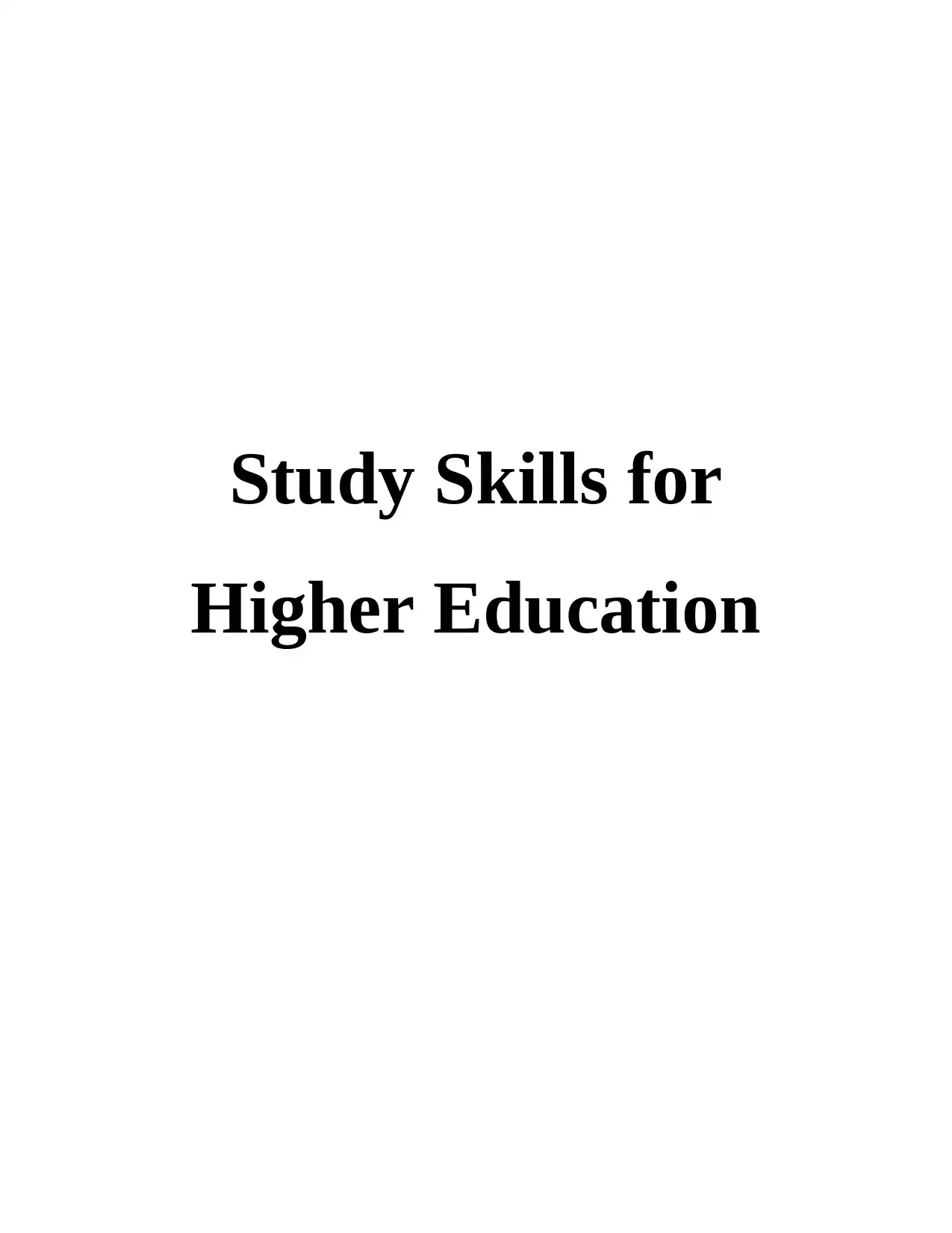
Study Skills for
Higher Education
Higher Education
Secure Best Marks with AI Grader
Need help grading? Try our AI Grader for instant feedback on your assignments.
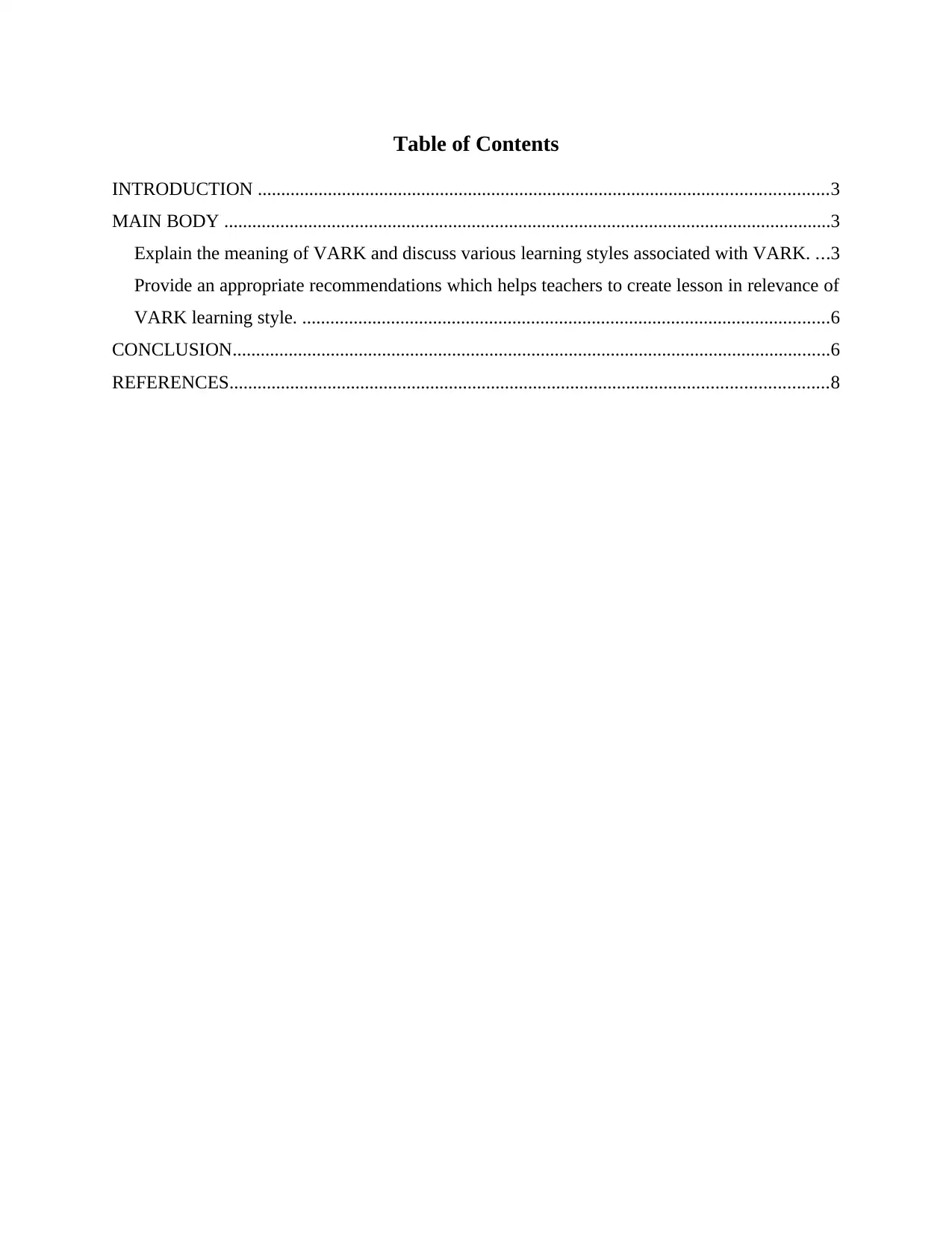
Table of Contents
INTRODUCTION ..........................................................................................................................3
MAIN BODY ..................................................................................................................................3
Explain the meaning of VARK and discuss various learning styles associated with VARK. ...3
Provide an appropriate recommendations which helps teachers to create lesson in relevance of
VARK learning style. .................................................................................................................6
CONCLUSION................................................................................................................................6
REFERENCES................................................................................................................................8
INTRODUCTION ..........................................................................................................................3
MAIN BODY ..................................................................................................................................3
Explain the meaning of VARK and discuss various learning styles associated with VARK. ...3
Provide an appropriate recommendations which helps teachers to create lesson in relevance of
VARK learning style. .................................................................................................................6
CONCLUSION................................................................................................................................6
REFERENCES................................................................................................................................8
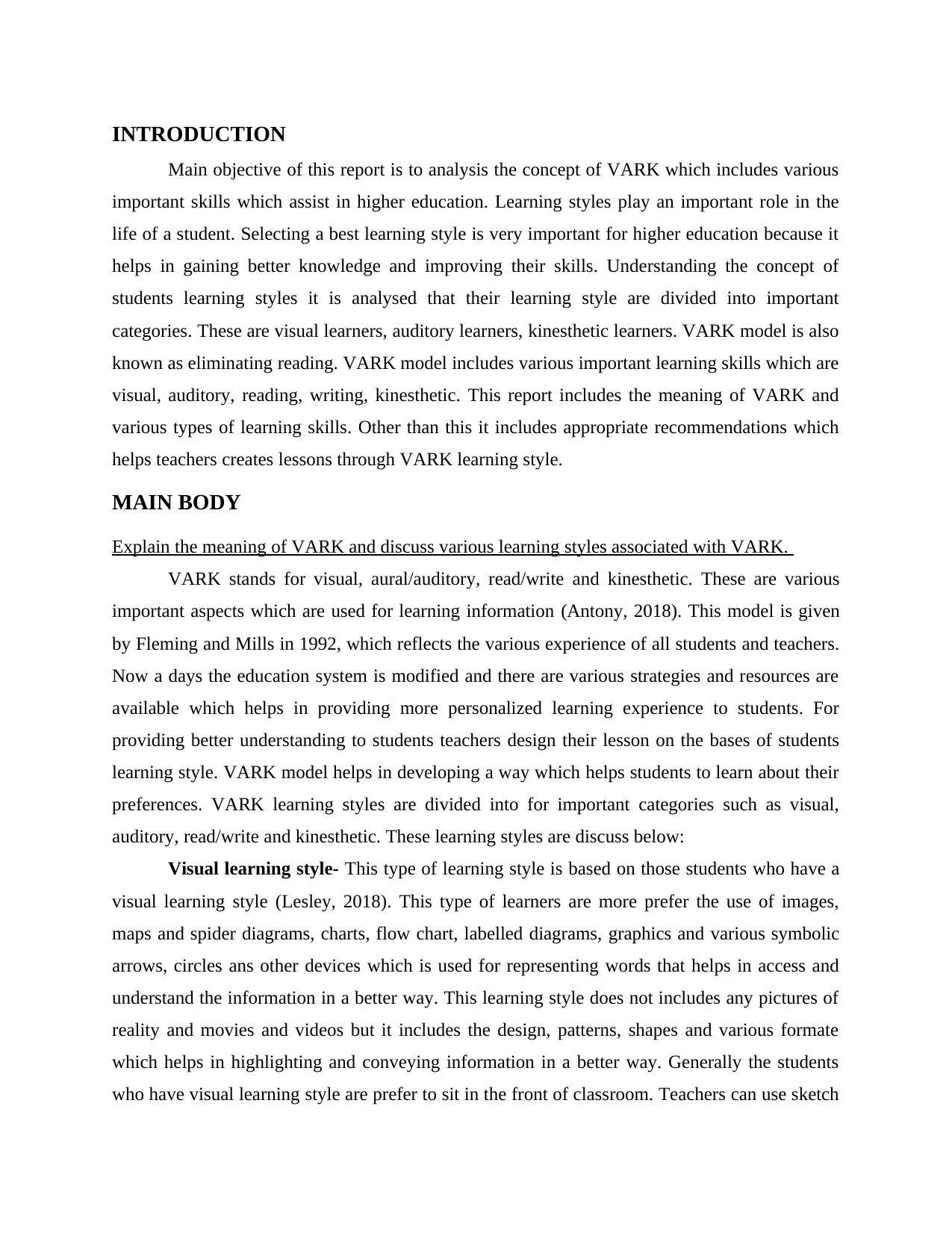
INTRODUCTION
Main objective of this report is to analysis the concept of VARK which includes various
important skills which assist in higher education. Learning styles play an important role in the
life of a student. Selecting a best learning style is very important for higher education because it
helps in gaining better knowledge and improving their skills. Understanding the concept of
students learning styles it is analysed that their learning style are divided into important
categories. These are visual learners, auditory learners, kinesthetic learners. VARK model is also
known as eliminating reading. VARK model includes various important learning skills which are
visual, auditory, reading, writing, kinesthetic. This report includes the meaning of VARK and
various types of learning skills. Other than this it includes appropriate recommendations which
helps teachers creates lessons through VARK learning style.
MAIN BODY
Explain the meaning of VARK and discuss various learning styles associated with VARK.
VARK stands for visual, aural/auditory, read/write and kinesthetic. These are various
important aspects which are used for learning information (Antony, 2018). This model is given
by Fleming and Mills in 1992, which reflects the various experience of all students and teachers.
Now a days the education system is modified and there are various strategies and resources are
available which helps in providing more personalized learning experience to students. For
providing better understanding to students teachers design their lesson on the bases of students
learning style. VARK model helps in developing a way which helps students to learn about their
preferences. VARK learning styles are divided into for important categories such as visual,
auditory, read/write and kinesthetic. These learning styles are discuss below:
Visual learning style- This type of learning style is based on those students who have a
visual learning style (Lesley, 2018). This type of learners are more prefer the use of images,
maps and spider diagrams, charts, flow chart, labelled diagrams, graphics and various symbolic
arrows, circles ans other devices which is used for representing words that helps in access and
understand the information in a better way. This learning style does not includes any pictures of
reality and movies and videos but it includes the design, patterns, shapes and various formate
which helps in highlighting and conveying information in a better way. Generally the students
who have visual learning style are prefer to sit in the front of classroom. Teachers can use sketch
Main objective of this report is to analysis the concept of VARK which includes various
important skills which assist in higher education. Learning styles play an important role in the
life of a student. Selecting a best learning style is very important for higher education because it
helps in gaining better knowledge and improving their skills. Understanding the concept of
students learning styles it is analysed that their learning style are divided into important
categories. These are visual learners, auditory learners, kinesthetic learners. VARK model is also
known as eliminating reading. VARK model includes various important learning skills which are
visual, auditory, reading, writing, kinesthetic. This report includes the meaning of VARK and
various types of learning skills. Other than this it includes appropriate recommendations which
helps teachers creates lessons through VARK learning style.
MAIN BODY
Explain the meaning of VARK and discuss various learning styles associated with VARK.
VARK stands for visual, aural/auditory, read/write and kinesthetic. These are various
important aspects which are used for learning information (Antony, 2018). This model is given
by Fleming and Mills in 1992, which reflects the various experience of all students and teachers.
Now a days the education system is modified and there are various strategies and resources are
available which helps in providing more personalized learning experience to students. For
providing better understanding to students teachers design their lesson on the bases of students
learning style. VARK model helps in developing a way which helps students to learn about their
preferences. VARK learning styles are divided into for important categories such as visual,
auditory, read/write and kinesthetic. These learning styles are discuss below:
Visual learning style- This type of learning style is based on those students who have a
visual learning style (Lesley, 2018). This type of learners are more prefer the use of images,
maps and spider diagrams, charts, flow chart, labelled diagrams, graphics and various symbolic
arrows, circles ans other devices which is used for representing words that helps in access and
understand the information in a better way. This learning style does not includes any pictures of
reality and movies and videos but it includes the design, patterns, shapes and various formate
which helps in highlighting and conveying information in a better way. Generally the students
who have visual learning style are prefer to sit in the front of classroom. Teachers can use sketch
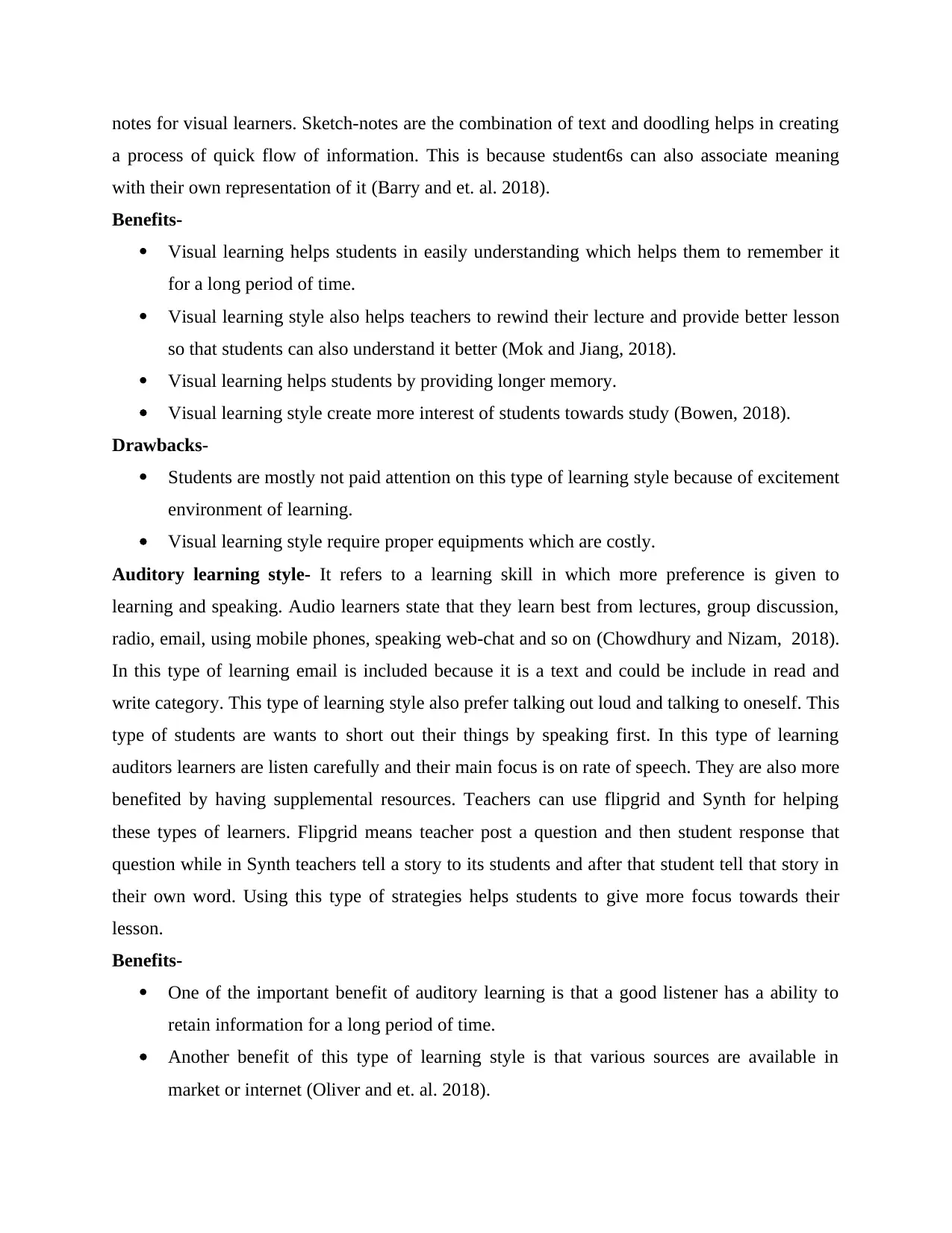
notes for visual learners. Sketch-notes are the combination of text and doodling helps in creating
a process of quick flow of information. This is because student6s can also associate meaning
with their own representation of it (Barry and et. al. 2018).
Benefits-
Visual learning helps students in easily understanding which helps them to remember it
for a long period of time.
Visual learning style also helps teachers to rewind their lecture and provide better lesson
so that students can also understand it better (Mok and Jiang, 2018).
Visual learning helps students by providing longer memory.
Visual learning style create more interest of students towards study (Bowen, 2018).
Drawbacks-
Students are mostly not paid attention on this type of learning style because of excitement
environment of learning.
Visual learning style require proper equipments which are costly.
Auditory learning style- It refers to a learning skill in which more preference is given to
learning and speaking. Audio learners state that they learn best from lectures, group discussion,
radio, email, using mobile phones, speaking web-chat and so on (Chowdhury and Nizam, 2018).
In this type of learning email is included because it is a text and could be include in read and
write category. This type of learning style also prefer talking out loud and talking to oneself. This
type of students are wants to short out their things by speaking first. In this type of learning
auditors learners are listen carefully and their main focus is on rate of speech. They are also more
benefited by having supplemental resources. Teachers can use flipgrid and Synth for helping
these types of learners. Flipgrid means teacher post a question and then student response that
question while in Synth teachers tell a story to its students and after that student tell that story in
their own word. Using this type of strategies helps students to give more focus towards their
lesson.
Benefits-
One of the important benefit of auditory learning is that a good listener has a ability to
retain information for a long period of time.
Another benefit of this type of learning style is that various sources are available in
market or internet (Oliver and et. al. 2018).
a process of quick flow of information. This is because student6s can also associate meaning
with their own representation of it (Barry and et. al. 2018).
Benefits-
Visual learning helps students in easily understanding which helps them to remember it
for a long period of time.
Visual learning style also helps teachers to rewind their lecture and provide better lesson
so that students can also understand it better (Mok and Jiang, 2018).
Visual learning helps students by providing longer memory.
Visual learning style create more interest of students towards study (Bowen, 2018).
Drawbacks-
Students are mostly not paid attention on this type of learning style because of excitement
environment of learning.
Visual learning style require proper equipments which are costly.
Auditory learning style- It refers to a learning skill in which more preference is given to
learning and speaking. Audio learners state that they learn best from lectures, group discussion,
radio, email, using mobile phones, speaking web-chat and so on (Chowdhury and Nizam, 2018).
In this type of learning email is included because it is a text and could be include in read and
write category. This type of learning style also prefer talking out loud and talking to oneself. This
type of students are wants to short out their things by speaking first. In this type of learning
auditors learners are listen carefully and their main focus is on rate of speech. They are also more
benefited by having supplemental resources. Teachers can use flipgrid and Synth for helping
these types of learners. Flipgrid means teacher post a question and then student response that
question while in Synth teachers tell a story to its students and after that student tell that story in
their own word. Using this type of strategies helps students to give more focus towards their
lesson.
Benefits-
One of the important benefit of auditory learning is that a good listener has a ability to
retain information for a long period of time.
Another benefit of this type of learning style is that various sources are available in
market or internet (Oliver and et. al. 2018).
Secure Best Marks with AI Grader
Need help grading? Try our AI Grader for instant feedback on your assignments.
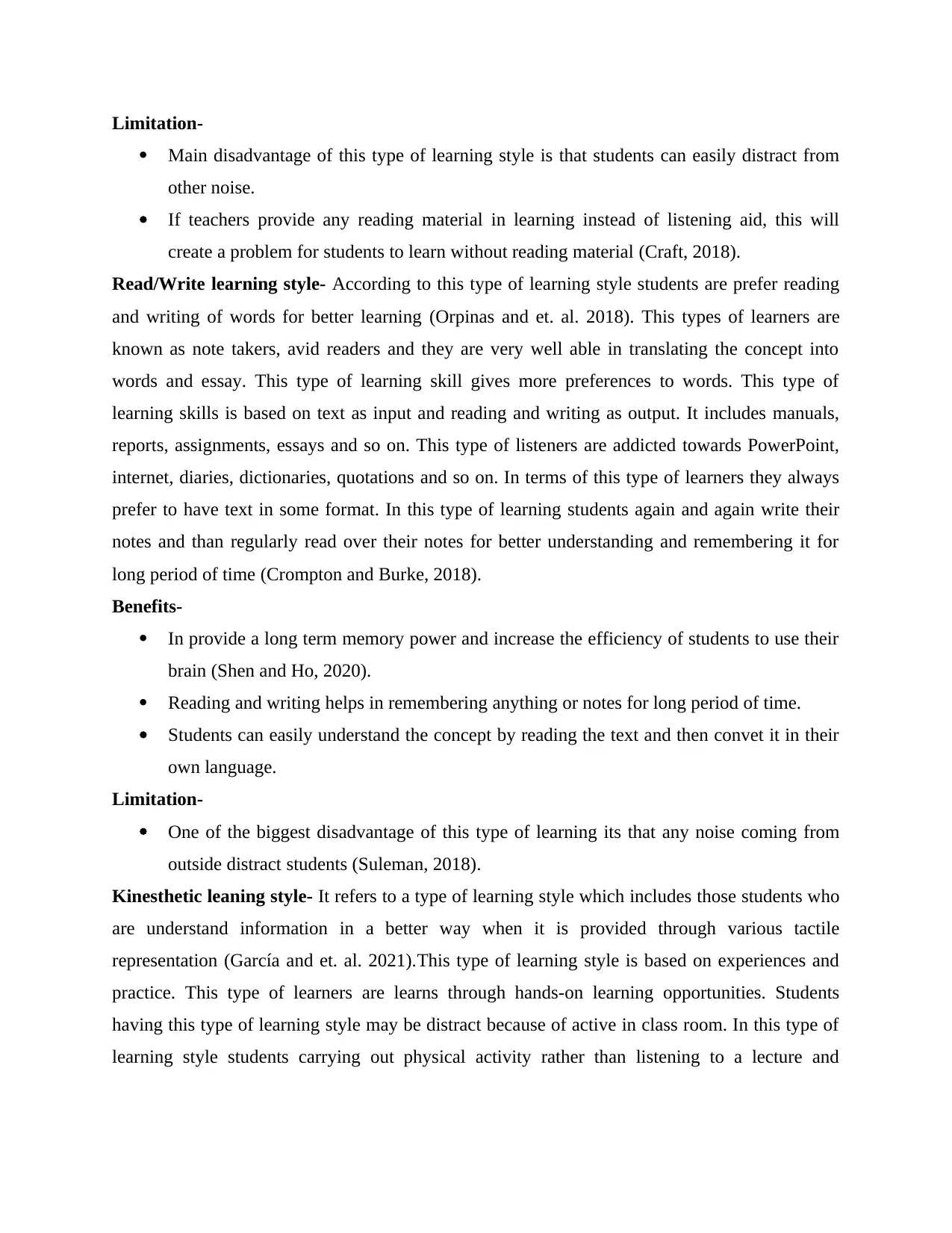
Limitation-
Main disadvantage of this type of learning style is that students can easily distract from
other noise.
If teachers provide any reading material in learning instead of listening aid, this will
create a problem for students to learn without reading material (Craft, 2018).
Read/Write learning style- According to this type of learning style students are prefer reading
and writing of words for better learning (Orpinas and et. al. 2018). This types of learners are
known as note takers, avid readers and they are very well able in translating the concept into
words and essay. This type of learning skill gives more preferences to words. This type of
learning skills is based on text as input and reading and writing as output. It includes manuals,
reports, assignments, essays and so on. This type of listeners are addicted towards PowerPoint,
internet, diaries, dictionaries, quotations and so on. In terms of this type of learners they always
prefer to have text in some format. In this type of learning students again and again write their
notes and than regularly read over their notes for better understanding and remembering it for
long period of time (Crompton and Burke, 2018).
Benefits-
In provide a long term memory power and increase the efficiency of students to use their
brain (Shen and Ho, 2020).
Reading and writing helps in remembering anything or notes for long period of time.
Students can easily understand the concept by reading the text and then convet it in their
own language.
Limitation-
One of the biggest disadvantage of this type of learning its that any noise coming from
outside distract students (Suleman, 2018).
Kinesthetic leaning style- It refers to a type of learning style which includes those students who
are understand information in a better way when it is provided through various tactile
representation (García and et. al. 2021).This type of learning style is based on experiences and
practice. This type of learners are learns through hands-on learning opportunities. Students
having this type of learning style may be distract because of active in class room. In this type of
learning style students carrying out physical activity rather than listening to a lecture and
Main disadvantage of this type of learning style is that students can easily distract from
other noise.
If teachers provide any reading material in learning instead of listening aid, this will
create a problem for students to learn without reading material (Craft, 2018).
Read/Write learning style- According to this type of learning style students are prefer reading
and writing of words for better learning (Orpinas and et. al. 2018). This types of learners are
known as note takers, avid readers and they are very well able in translating the concept into
words and essay. This type of learning skill gives more preferences to words. This type of
learning skills is based on text as input and reading and writing as output. It includes manuals,
reports, assignments, essays and so on. This type of listeners are addicted towards PowerPoint,
internet, diaries, dictionaries, quotations and so on. In terms of this type of learners they always
prefer to have text in some format. In this type of learning students again and again write their
notes and than regularly read over their notes for better understanding and remembering it for
long period of time (Crompton and Burke, 2018).
Benefits-
In provide a long term memory power and increase the efficiency of students to use their
brain (Shen and Ho, 2020).
Reading and writing helps in remembering anything or notes for long period of time.
Students can easily understand the concept by reading the text and then convet it in their
own language.
Limitation-
One of the biggest disadvantage of this type of learning its that any noise coming from
outside distract students (Suleman, 2018).
Kinesthetic leaning style- It refers to a type of learning style which includes those students who
are understand information in a better way when it is provided through various tactile
representation (García and et. al. 2021).This type of learning style is based on experiences and
practice. This type of learners are learns through hands-on learning opportunities. Students
having this type of learning style may be distract because of active in class room. In this type of
learning style students carrying out physical activity rather than listening to a lecture and
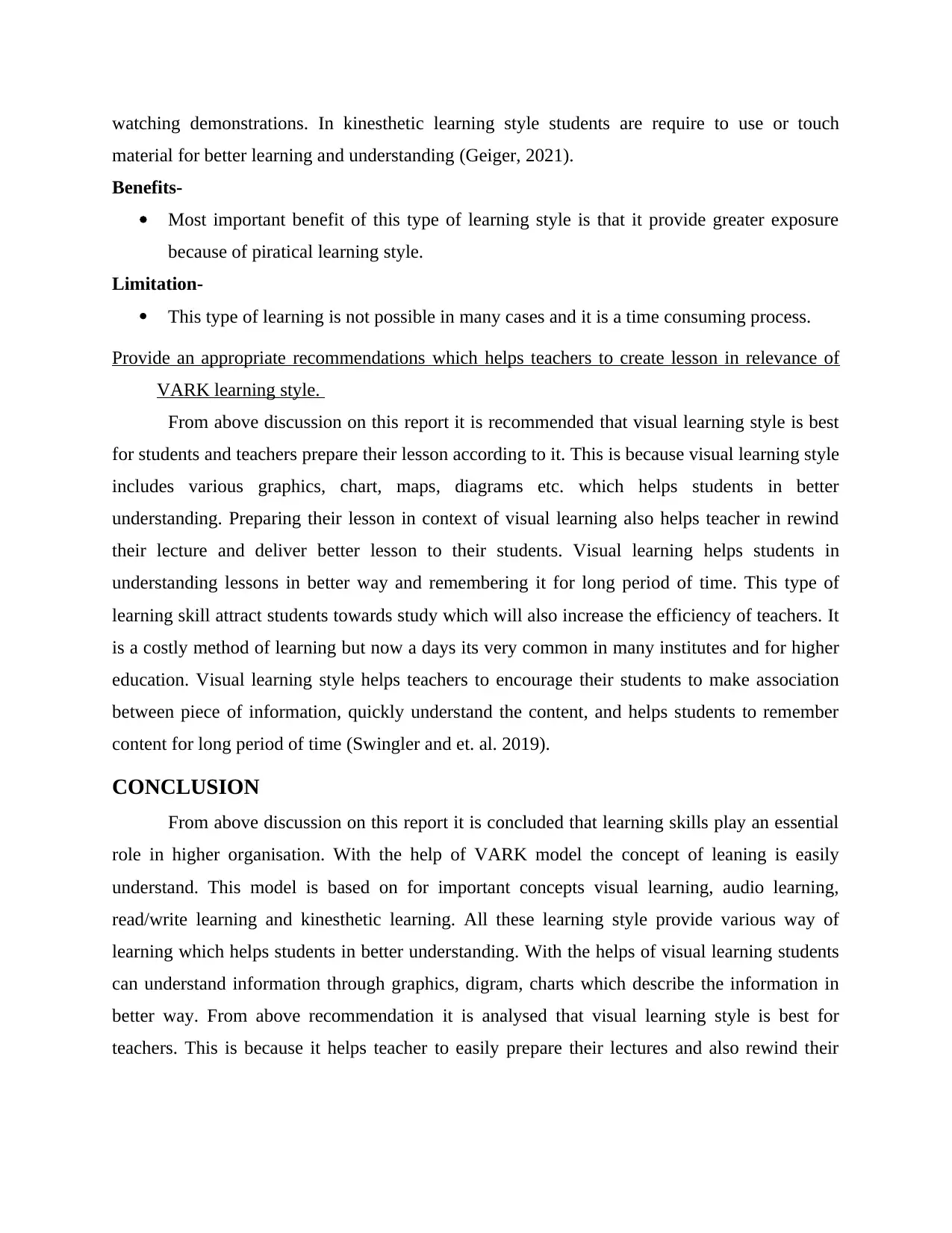
watching demonstrations. In kinesthetic learning style students are require to use or touch
material for better learning and understanding (Geiger, 2021).
Benefits-
Most important benefit of this type of learning style is that it provide greater exposure
because of piratical learning style.
Limitation-
This type of learning is not possible in many cases and it is a time consuming process.
Provide an appropriate recommendations which helps teachers to create lesson in relevance of
VARK learning style.
From above discussion on this report it is recommended that visual learning style is best
for students and teachers prepare their lesson according to it. This is because visual learning style
includes various graphics, chart, maps, diagrams etc. which helps students in better
understanding. Preparing their lesson in context of visual learning also helps teacher in rewind
their lecture and deliver better lesson to their students. Visual learning helps students in
understanding lessons in better way and remembering it for long period of time. This type of
learning skill attract students towards study which will also increase the efficiency of teachers. It
is a costly method of learning but now a days its very common in many institutes and for higher
education. Visual learning style helps teachers to encourage their students to make association
between piece of information, quickly understand the content, and helps students to remember
content for long period of time (Swingler and et. al. 2019).
CONCLUSION
From above discussion on this report it is concluded that learning skills play an essential
role in higher organisation. With the help of VARK model the concept of leaning is easily
understand. This model is based on for important concepts visual learning, audio learning,
read/write learning and kinesthetic learning. All these learning style provide various way of
learning which helps students in better understanding. With the helps of visual learning students
can understand information through graphics, digram, charts which describe the information in
better way. From above recommendation it is analysed that visual learning style is best for
teachers. This is because it helps teacher to easily prepare their lectures and also rewind their
material for better learning and understanding (Geiger, 2021).
Benefits-
Most important benefit of this type of learning style is that it provide greater exposure
because of piratical learning style.
Limitation-
This type of learning is not possible in many cases and it is a time consuming process.
Provide an appropriate recommendations which helps teachers to create lesson in relevance of
VARK learning style.
From above discussion on this report it is recommended that visual learning style is best
for students and teachers prepare their lesson according to it. This is because visual learning style
includes various graphics, chart, maps, diagrams etc. which helps students in better
understanding. Preparing their lesson in context of visual learning also helps teacher in rewind
their lecture and deliver better lesson to their students. Visual learning helps students in
understanding lessons in better way and remembering it for long period of time. This type of
learning skill attract students towards study which will also increase the efficiency of teachers. It
is a costly method of learning but now a days its very common in many institutes and for higher
education. Visual learning style helps teachers to encourage their students to make association
between piece of information, quickly understand the content, and helps students to remember
content for long period of time (Swingler and et. al. 2019).
CONCLUSION
From above discussion on this report it is concluded that learning skills play an essential
role in higher organisation. With the help of VARK model the concept of leaning is easily
understand. This model is based on for important concepts visual learning, audio learning,
read/write learning and kinesthetic learning. All these learning style provide various way of
learning which helps students in better understanding. With the helps of visual learning students
can understand information through graphics, digram, charts which describe the information in
better way. From above recommendation it is analysed that visual learning style is best for
teachers. This is because it helps teacher to easily prepare their lectures and also rewind their

lecture for better understanding. Form above report it is analysed that selecting a best learning
style is very important for higher educations.
style is very important for higher educations.
Paraphrase This Document
Need a fresh take? Get an instant paraphrase of this document with our AI Paraphraser
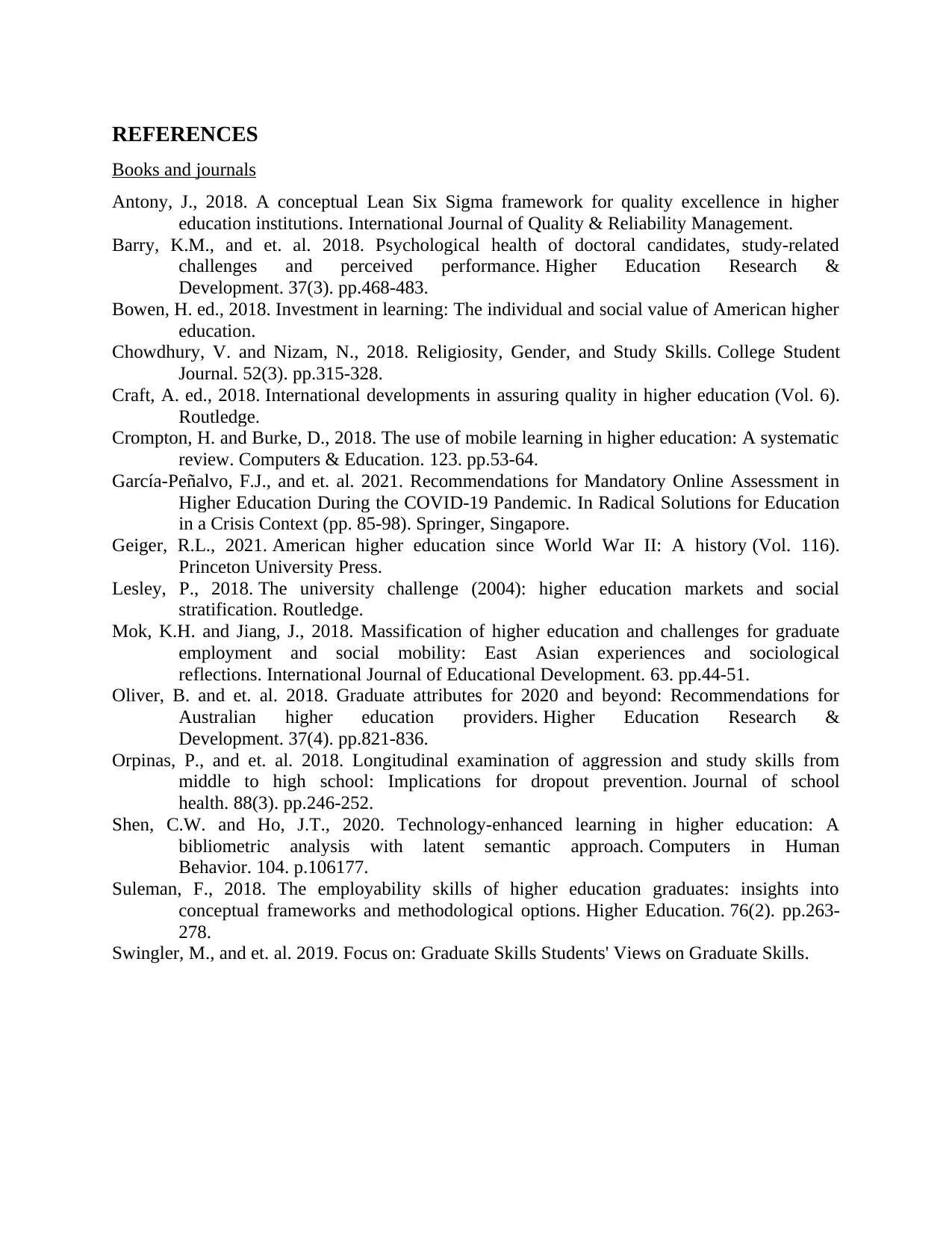
REFERENCES
Books and journals
Antony, J., 2018. A conceptual Lean Six Sigma framework for quality excellence in higher
education institutions. International Journal of Quality & Reliability Management.
Barry, K.M., and et. al. 2018. Psychological health of doctoral candidates, study-related
challenges and perceived performance. Higher Education Research &
Development. 37(3). pp.468-483.
Bowen, H. ed., 2018. Investment in learning: The individual and social value of American higher
education.
Chowdhury, V. and Nizam, N., 2018. Religiosity, Gender, and Study Skills. College Student
Journal. 52(3). pp.315-328.
Craft, A. ed., 2018. International developments in assuring quality in higher education (Vol. 6).
Routledge.
Crompton, H. and Burke, D., 2018. The use of mobile learning in higher education: A systematic
review. Computers & Education. 123. pp.53-64.
García-Peñalvo, F.J., and et. al. 2021. Recommendations for Mandatory Online Assessment in
Higher Education During the COVID-19 Pandemic. In Radical Solutions for Education
in a Crisis Context (pp. 85-98). Springer, Singapore.
Geiger, R.L., 2021. American higher education since World War II: A history (Vol. 116).
Princeton University Press.
Lesley, P., 2018. The university challenge (2004): higher education markets and social
stratification. Routledge.
Mok, K.H. and Jiang, J., 2018. Massification of higher education and challenges for graduate
employment and social mobility: East Asian experiences and sociological
reflections. International Journal of Educational Development. 63. pp.44-51.
Oliver, B. and et. al. 2018. Graduate attributes for 2020 and beyond: Recommendations for
Australian higher education providers. Higher Education Research &
Development. 37(4). pp.821-836.
Orpinas, P., and et. al. 2018. Longitudinal examination of aggression and study skills from
middle to high school: Implications for dropout prevention. Journal of school
health. 88(3). pp.246-252.
Shen, C.W. and Ho, J.T., 2020. Technology-enhanced learning in higher education: A
bibliometric analysis with latent semantic approach. Computers in Human
Behavior. 104. p.106177.
Suleman, F., 2018. The employability skills of higher education graduates: insights into
conceptual frameworks and methodological options. Higher Education. 76(2). pp.263-
278.
Swingler, M., and et. al. 2019. Focus on: Graduate Skills Students' Views on Graduate Skills.
Books and journals
Antony, J., 2018. A conceptual Lean Six Sigma framework for quality excellence in higher
education institutions. International Journal of Quality & Reliability Management.
Barry, K.M., and et. al. 2018. Psychological health of doctoral candidates, study-related
challenges and perceived performance. Higher Education Research &
Development. 37(3). pp.468-483.
Bowen, H. ed., 2018. Investment in learning: The individual and social value of American higher
education.
Chowdhury, V. and Nizam, N., 2018. Religiosity, Gender, and Study Skills. College Student
Journal. 52(3). pp.315-328.
Craft, A. ed., 2018. International developments in assuring quality in higher education (Vol. 6).
Routledge.
Crompton, H. and Burke, D., 2018. The use of mobile learning in higher education: A systematic
review. Computers & Education. 123. pp.53-64.
García-Peñalvo, F.J., and et. al. 2021. Recommendations for Mandatory Online Assessment in
Higher Education During the COVID-19 Pandemic. In Radical Solutions for Education
in a Crisis Context (pp. 85-98). Springer, Singapore.
Geiger, R.L., 2021. American higher education since World War II: A history (Vol. 116).
Princeton University Press.
Lesley, P., 2018. The university challenge (2004): higher education markets and social
stratification. Routledge.
Mok, K.H. and Jiang, J., 2018. Massification of higher education and challenges for graduate
employment and social mobility: East Asian experiences and sociological
reflections. International Journal of Educational Development. 63. pp.44-51.
Oliver, B. and et. al. 2018. Graduate attributes for 2020 and beyond: Recommendations for
Australian higher education providers. Higher Education Research &
Development. 37(4). pp.821-836.
Orpinas, P., and et. al. 2018. Longitudinal examination of aggression and study skills from
middle to high school: Implications for dropout prevention. Journal of school
health. 88(3). pp.246-252.
Shen, C.W. and Ho, J.T., 2020. Technology-enhanced learning in higher education: A
bibliometric analysis with latent semantic approach. Computers in Human
Behavior. 104. p.106177.
Suleman, F., 2018. The employability skills of higher education graduates: insights into
conceptual frameworks and methodological options. Higher Education. 76(2). pp.263-
278.
Swingler, M., and et. al. 2019. Focus on: Graduate Skills Students' Views on Graduate Skills.
1 out of 8
Related Documents
Your All-in-One AI-Powered Toolkit for Academic Success.
+13062052269
info@desklib.com
Available 24*7 on WhatsApp / Email
![[object Object]](/_next/static/media/star-bottom.7253800d.svg)
Unlock your academic potential
© 2024 | Zucol Services PVT LTD | All rights reserved.



